by Lisa Cooke | May 20, 2019 | 01 What's New, DNA, MyHeritage
New on the DNA Front: The new MyHeritage DNA Health + Ancestry test is now available and provides comprehensive health reports for conditions affected by genetics including heart disease, breast cancer, type 2 diabetes, and Alzheimer’s disease. Plus you’ll still get the genealogy tools for matching and discovering common ancestors. Read on to learn more about what health data is provided, how to order, the privacy policy, and more. Also keep in mind that DNA and health testing are a personal responsibility and decision, and the information provided below is for informational purposes only.
MyHeritage Expands to Health
From the MyHeritage press release: Tel Aviv, Israel & Lehi, Utah — MyHeritage, the leading global service for family history and DNA testing, announced today a major expansion of its DNA product line with the launch of the
MyHeritage DNA Health + Ancestry test. The test provides a new dimension of genetic insight with comprehensive health reports that can empower future health and lifestyle choices. It is a superset of the current MyHeritage DNA Ancestry-Only test, and includes its pillar features: a percentage breakdown of ethnic origins and matching to relatives through shared DNA. MyHeritage is now the only global consumer DNA company to offer an extensive health and ancestry product in over 40 languages.
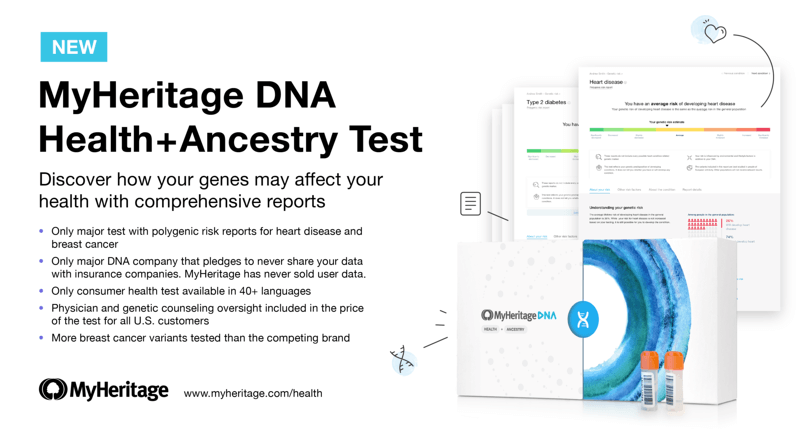
The launch of the Health + Ancestry product distinguishes MyHeritage as the only major service that bridges consumers’ past, present, and future: MyHeritage’s integrated suite of products enable users to discover their family history and ethnic origins, find new relatives, and receive valuable insights to help manage choices regarding their health that may impact their future well-being.
“Our Health + Ancestry test is the next step in the evolution of MyHeritage. After 16 years of changing lives for the better through family history research and genetic genealogy, we are excited to expand our mission and try to improve and save lives as well. Our vision is to integrate our successful family history technologies with the new health product in innovative ways that bridge heritage and heredity to deliver deeper insights for our users,” said Gilad Japhet, founder and CEO of MyHeritage. “We are proud to be part of a movement to democratize healthcare globally and make genetic testing accessible to millions of people, and allow them to discover what makes them unique.”
What Health Data is Included?
According to the company, The MyHeritage DNA Health + Ancestry test provides health reports that show users their risk of developing or carrying genetic conditions. Reports include conditions where specific genes contribute to the risk, such as hereditary breast cancer, late-onset Alzheimer’s disease, and late-onset Parkinson’s disease; conditions associated with multiple genes, such as heart disease, and type 2 diabetes; and carrier status reports on conditions that can be passed down from a couple to their children, such as Tay-Sachs disease and cystic fibrosis.
In total, MyHeritage’s Health + Ancestry test covers one of the most extensive ranges of conditions offered by an at-home DNA test: 11 Genetic Risk Reports, including a hereditary breast cancer (BRCA) report that tests 10 pathogenic variants; 3 Polygenic Risk Reports; and 15 Carrier Status Reports.
Taking the Test
MyHeritage DNA Health + Ancestry is a Laboratory Developed Test, processed in a CLIA certified and CAP accredited DNA lab in Texas. The at-home DNA test is an easy and painless cheek swab, and does not require spitting as some other tests do, which makes it more suitable and convenient for all populations, including older people.
Health reports only determine users’ genetic risk for the supported conditions. However, all users are required to complete a personal and family health history questionnaire, to ensure that each user receives the reports appropriate for them. MyHeritage works with PWNHealth, an independent physician network and genetic counseling service, to provide end-to-end physician oversight of the MyHeritage DNA Health + Ancestry test for all U.S. customers, which includes genetic counseling, if appropriate. PWNHealth’s physician oversight and genetic counseling fee is included in the total price.
Your Health Data is Private
Privacy is strictly enforced. All health data is protected by state-of-the-art encryption. Health report data is secured using additional password protection and is so secure that even MyHeritage employees cannot access it. MyHeritage has never licensed or sold user data, and has committed to never do so without obtaining explicit user consent. MyHeritage is the only consumer DNA company that has pledged to never sell data to insurance companies. It also applies a strict policy to prohibit use of its DNA services by law enforcement agencies.
Pricing & Ordering
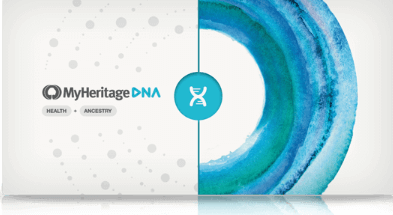
The MyHeritage DNA Health + Ancestry kit is available at the price of
$199 + shipping. Users who have already purchased a MyHeritage DNA test for ethnicity and genealogy matching can upgrade to receive health reports for $120. To order, visit the
MyHeritage DNA website. An annual Health subscription is available as an optional add-on to the new DNA kit, which grants users access to new health reports as they are released. As a special benefit for the launch, the Health subscription is currently offered for free for the first twelve months and users can cancel it anytime.
Disclaimer
The new health product is not intended to independently diagnose, prevent, or treat any disease or condition or tell users anything about their current state of health in the absence of medical and clinical information.
The product is also not intended for making medical decisions, including prescription or dosing of medications. Users may need to obtain further services from their physician, a genetic counselor, or other healthcare provider, in order to obtain diagnostic results regarding the conditions or diseases indicated within the MyHeritage DNA health reports.
The health reports provide genetic risk information based on assessment of specific genetic variants but do not report on users’ entire genetic profile. The health reports do not detect all genetic variants related to a given disease, and the absence of a variant tested does not rule out the presence of other genetic variants that may be related to the disease.
For most diseases, currently known genes are only responsible for a portion of the overall risk. Other factors such as environment and lifestyle may affect the risk of developing a given disease and, depending on the condition, may be more relevant predictors.
If a user’s data indicate that the user is not at elevated genetic risk for a disease or condition, this should not be interpreted as meaning that the user is safe from developing the disease or condition. The opposite is also true; if a user’s data indicates that the user is at an elevated genetic risk for a disease or condition, it does not mean that the user will definitively develop the disease or condition. Any findings within the health reports should be confirmed and supplemented by additional medical and clinical testing as recommended by the user’s healthcare provider.
MyHeritage DNA Health + Ancestry is available globally except in a few countries that do not allow health-related consumer genetic testing. In the USA, it is available in all states except New York, New Jersey, and Rhode Island, where separate laboratory certifications are required and are currently being pursued. Altogether, MyHeritage DNA Health + Ancestry is now the genetic test for health available in the greatest number of languages and with the widest global reach.
Disclosure: This article is a press release provided by MyHeritage. It is intended for informational purposes, and not intended as a promotion of DNA health tests. This article does contain affiliate links and Genealogy Gems will be compensated if you make a purchase after clicking on these links (at no additional cost to you).
by Diahan Southard | Apr 5, 2019 | 01 What's New, Adoption, DNA |
Combining DNA test types can give you a better picture of your overall genealogical relationship to someone else. DNA expert Diahan Southard shares an example from her family about how she used different DNA tests to solve an adoption mystery.
Combine your autosomal test results with the results of your mitochondrial DNA or YDNA test to make some amazing connections today!
My family recently visited the Jelly Belly Factory in northern California. Of course, at the end of the tour, they funneled us into their gift shop where we felt compelled to buy jelly beans and other sundry treats.
My favorite part of the big box we bought were the recipes on the side. We could turn the already delicious variety of flavors into even more pallet-pleasing options by eating specific combinations of jelly beans at the same time. Like 2 green apply jelly beans + 1 cinnamon jelly bean = apple pie. Who knew!
Naturally, this got me thinking about DNA.
Combining DNA Test Types
Specifically, I was thinking about the power of combining multiple test types to get a better picture of our overall genealogical relationship to someone else.
If you recall, there are three kinds of DNA tests available for genealogists:
- Autosomal DNA
- Mitochondrial DNA (mtDNA)
- Y chromosome DNA (YDNA)
Much of the focus these days is on how to use the autosomal DNA in our family history research. This may be because the autosomal DNA covers both sides of your family tree, so it is seen as a catchall for our family history. While it is a very powerful tool for our research, it can also be a bit overwhelming to try to determine how you are related to someone else.
Let’s look at an example from my own family history.
My mom took an autosomal DNA test at 23andMe and matched with Tom. Their predicted genealogical relationship, based on how much DNA they shared, was second cousins.
To begin to understand how they are related, we need to understand which ancestor could be shared by people who are genetic second cousins. To figure it out, you can count backward like this: people who share parents are siblings, sharing grandparents makes you first cousins, and sharing great-grandparents makes you second cousins.
So, if my mom and Tom are true second cousins (meaning there aren’t any of those once-removed situations going on, but that’s a subject for another time), then we should be able to find their common ancestor among their great-grandparents.
Each of us has eight great-grandparents. Because we can’t usually narrow down shared DNA to a single person, but rather to an ancestral couple, we are really just looking at four possible ancestral couple connections between my mom and Tom.
My mom doesn’t have any known ancestors, as she was adopted, so we can only evaluate Tom’s line. Tom was kind enough to share his pedigree chart with us, and he had all four of his couples listed. But how do we know which one is the shared couple with my mom?

Narrowing Down the Results
Now, for those of you without an adoption, you will have some other clues to help you figure out which of the four (or eight, if you are looking at a third cousin, or 16 if you are looking at a fourth cousin) ancestral couples is shared between you and your match. Start by looking for shared surnames.
If that comes up short, evaluate each couple by location. If you see an ancestral couple who is in a similar location to your line, then that couple becomes your most likely connecting point.
What then? Do genealogy! Find out everything you can about that couple and their descendants to see if you can connect that line to your own.
However, in my mom’s case, we didn’t have any surnames or locations to narrow down which ancestral couple was the connection point between our line and Tom’s. But even if we had locations, that may not have helped as Tom is very homogenous. All of his ancestors were from the same place!
But, we did have one very important clue: the mitochondrial DNA. Remember mtDNA traces a direct maternal line. So my mom’s mtDNA is the same as her mom’s, which is the same as her mom’s etc.

At 23andMe they don’t test the full mitochondrial DNA sequence (FMS) like they do at Family Tree DNA. For family history purposes, you really want the FMS to help you narrow down your maternal line connection to others. But 23andMe does provide your haplogroup, otherwise known as your deep ancestral group. These groups are named with a letter/number combination. My mom is W1 and we noticed that Tom is also W1.
This meant that my mom and Tom share a direct maternal line – or put another way, Tom’s mother’s mother’s mother was the same as my mom’s mother’s mother’s mother. That means there is only one couple out of the four possible couples that could connect my mom to Tom: his direct maternal line ancestor Marianna Huck, and her husband Michael Wetzstien.
Now you can only perform this wondrous feat if you and your match have both tested at 23andMe, or have both taken the mtDNA test at Family Tree DNA.
Just as a Popcorn Jelly Belly plus two Blueberry Jelly Bellies makes a blueberry muffin, combining your autosomal DNA test results with your mtDNA test results (or YDNA for that matter) can yield some interesting connections that just might break down that family history brick wall.
Get your mtDNA and YDNA tested at Family Tree DNA
If you are considering testing your YDNA and/or your mtDNA, then Family Tree DNA is the place for you!
Even if you aren’t trying to solve an adoption mystery, you can utilize these additional tests to break down other brick walls in your genealogical research and learn more about your heritage. You can take their Family Finder autosomal test, YDNA, or Mitochondrial (mtDNA) full sequence test. Click here to shop now!
About the Author: Diahan Southard has worked with the Sorenson Molecular Genealogy Foundation, and has been in the genetic genealogy industry since it has been an industry. She holds a degree in Microbiology and her creative side helps her break the science up into delicious bite-sized pieces for you. She’s the author of a full series of DNA guides for genealogists.
Disclosure: This article contains affiliate links and Genealogy Gems will be compensated if you make a purchase after clicking on these links (at no additional cost to you). Thank you for supporting Genealogy Gems!
This article was originally published on April 17, 2017 and updated on April 5, 2019.
by Lacey Cooke | Mar 14, 2019 | 01 What's New, DNA, MyHeritage
MyHeritage made some exciting DNA announcements at RootsTech 2019! We’ve got the recap here about all of the new tools that will help genealogists find their ancestors and living relatives: The Theory of Family Relativity™ and AutoClusters. These groundbreaking new premium features will provide solid leads on your genetic matches and their relationships to you, with clear and intuitive displays to help you visualize your data like never before.
The Theory of Family Relativity™
“MyHeritage has recently announced and launched what they’re calling the “holy grail” of genetic genealogy – and I’m inclined to agree! The Theory of Family Relativity™ finally bridges the gap between DNA matches and historical records by providing you with leads that explain the relationship between your matches based on both their DNA database AND their entire collection of family trees and historical records. MyHeritage replicates both the Geni and FamilySearch trees into their “Big Tree,” so the amount of time you’ll save on guesswork and cross-referencing is incalculable. You’ll still want to examine the theories that are presented and practice good genealogical methods to verify the correctness. But for the first time, historical records are now being factored into your match results automatically. Time for the genealogy happy dance!”
“Through this new feature, we provide you with leads explaining the relationship between your matches based on our entire collection of family trees and historical records, removing the guesswork, and saving you hours of research time. You can then examine the theories and the information associated with them and verify their correctness.
The Theory of Family Relativity™ is based on a big data graph that connects billions of data points drawn from thousands of databases on MyHeritage, in real time. We call it internally the “Big Tree”. Every node on this graph represents a person, and every edge depicts a blood relationship between two individuals that is described in a family tree or a historical record; or a match between two tree profiles that are likely to be the same person; or two records that are likely to be about the same person.”
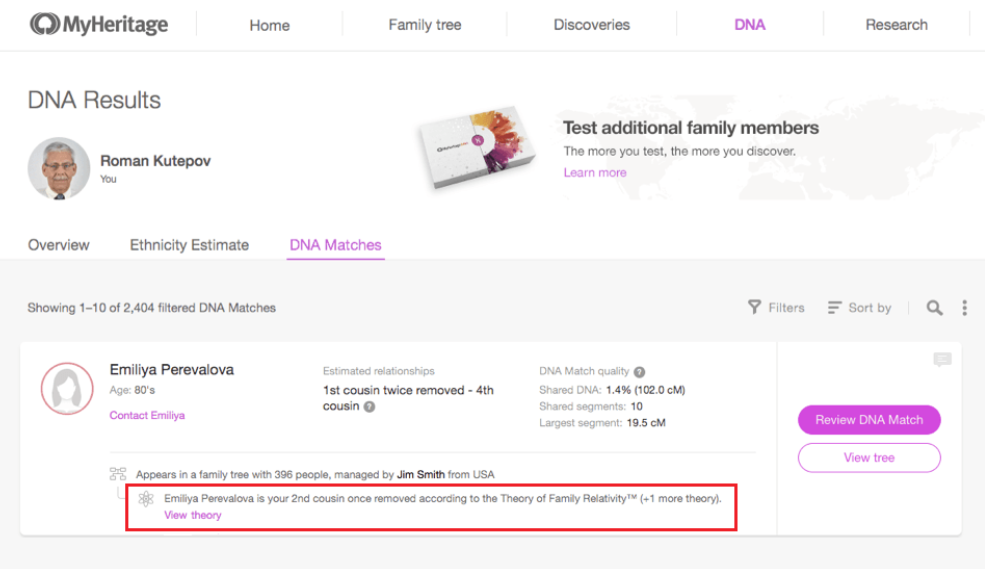
Here are the key takeaways from this new feature:
- The family trees and records used to develop the theory are fully integrated and accessible. From their blog: “Click “View full theory” to see a more detailed view that shows which family trees and historical records were used to establish the theory.”
- You may receive multiple theories about one match, and multiple paths showing how the algorithm came to that theory. Or you may receive none. The bigger your tree is, the better, and as more data is uploaded over time, the more information is available for the algorithm to find these theories.
- These are just theories, similar to hints. You still need to view and verify the sources yourself.
Theory of Family Relativity™ is a premium feature that requires a site subscription on MyHeritage (Premium or PremiumPlus or Complete). Users without a subscription will still see all theories that we found for them, but when they click to see the full theory details, some of the information will be hidden. For full details and explanations of how to access and use this feature, visit the MyHeritage blog.
Autoclusters
From the blog: “We’re excited to introduce AutoClusters — a new genetic genealogy tool that groups together DNA Matches that likely descend from common ancestors in a compelling visual chart. This easy-to-use tool helps you explore your DNA Matches more efficiently in groups rather than as numerous individuals, and gain insights about branches in your family tree.”
One of the limitations of DNA testing for genealogy is that testing companies can often only predict your match’s relationship to you, and genetically speaking, there are a lot of possibilities. For a family historian, estimated relationships can be a good lead, but often cause more frustration than assistance in their research. MyHeritage’s new AutoClusters tool aims to alleviate that frustration and provide helpful insights when a concrete relationship cannot be confirmed.
“AutoClusters organizes your MyHeritage DNA Matches into shared match clusters that likely descended from common ancestors. By grouping together DNA Matches who likely belong to the same branch and have a common ancestor, AutoClusters can be very helpful in shedding light on the relationship paths that connect you and your matches. By reviewing family trees of clustered matches, users can piece together the entire branch. Clusters are color-coded for convenience and are presented in a powerful visual chart, as well as in list format.”
AutoClusters is a premium feature that requires a website subscription on MyHeritage (Premium, PremiumPlus or Complete). Learn more about accessing and using the new AutoClusters tool on the MyHeritage Blog.
Get started with MyHeritage DNA today!
You can order a MyHeritage DNA kit right now for just $59 during their St. Patrick’s Day sale! As a bonus, get free shipping when you order 2 or more kits. This sale price is valid through March 18, 2019. If you’ve already tested with another testing company, you can also upload your results to MyHeritage for FREE! You’ll get unlimited free matching as well as the ability to contact your matches. To access these new features and other tools like the ethnicity estimate, shared ancestral places, chromosome browser, etc., it’s a simple one-time charge of $29. Click here to get started with MyHeritage DNA today!
Listen to Genealogy Gems Podcast Episode 227
Featuring the full length interview with Ran Snir, MyHeritage DNA Product Manager
(Click player on the right to unmute sound)
by Lacey Cooke | Dec 3, 2018 | 01 What's New, Ancestry, DNA |
Get a new perspective on your DNA results with AncestryDNA’s new Genetic Traits feature. For just $10, you can discover how traits run in your family and might even come from ethnic origins, with no additional DNA test needed. It’s a deeper look into what makes you YOU, and it’s a fantastic way to engage non-genealogists in your family to be interested in where they come from.
Share Traits This Holiday Season
While the new Genetic Traits feature from AncestryDNA may not be directly applicable to genealogical research or uncovering brick wall ancestors, it’s the ideal tool to interest the non-genealogist in your family. Your relatives might not be interested in cousin-matching and identifying shared ancestors, but they will love discovering what makes them unique. The Genetic Traits tool provides another vehicle for people to discover their origins and connect with their past in a meaningful way. If you’re giving a DNA test kit as a gift this year, consider gifting the Traits feature as well. And have fun exploring your own traits! Order now at Ancestry.com or on Amazon.
New AncestryDNA Feature: Genetic Traits
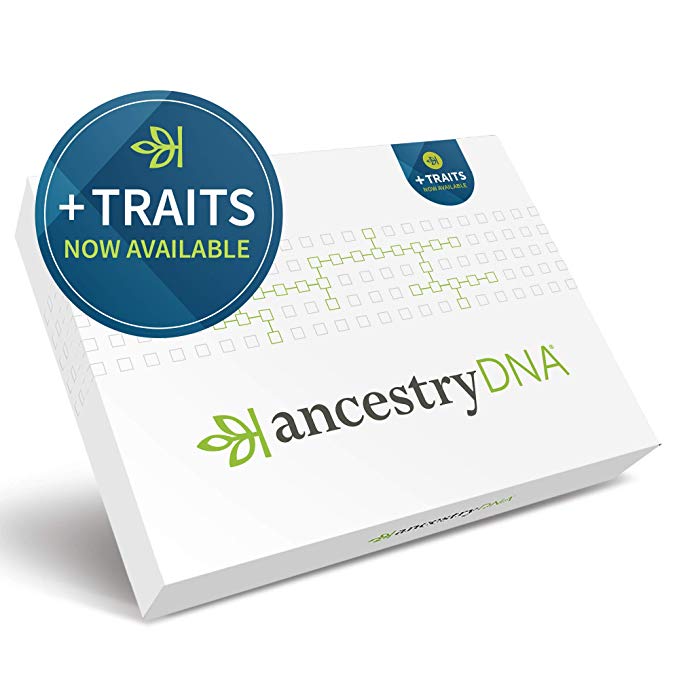
November 9, 2018: “Ancestry’s long history of innovation has driven our leadership in family history and, more recently, the emerging field of consumer genomics. Today, we’re proud to introduce a fun and innovative way for you to further explore who you are and where you come from – AncestryDNA Traits. Using science and data to power ongoing journeys of discovery, Traits is a new interactive experience that allows you to discover traits and attributes influenced by your DNA. With AncestryDNA Traits, you can explore up to 18 traits and attributes that you’ve inherited from your ancestors, share with family, and may pass down to future generations.”
Through AncestryDNA Traits, people can:
- Identify 18 traits (full list below)
- Compare your genetic markers to your matches via the AncestryDNA mobile app to see who in your family you share certain traits with.
- Explore an “Around the World” interactive map, where you can see how your traits align with your heritage.
- New customers can upgrade their AncestryDNA kit to include Traits for an additional $10.00 on Ancestry.com and Amazon. Existing customers can purchase the Traits feature for $10.00 through their Ancestry account.
Identifiable Traits
With AncestryDNA Traits, customers can explore up to 18 traits and attributes including:
- Finger length
- Cleft chin
- Earlobe type
- Earwax type
- Eye color
- Freckles
- Hair color
- Hair type
- Hair strand thickness
- Iris patterns
- Male hair loss
- Skin pigmentation
- Unibrow
- Bitter taste perception
- Sweet taste perception
- Savory taste perception
- Asparagus metabolite detection
- Cilantro aversion
More About Traits
From Ancestry: “Powered by AncestryDNA, Traits gives you an even deeper look at your personal story through the “Around the World” interactive map. You can explore how your traits align with your heritage and learn whether your green eyes are common in other people with Irish ancestry.
Those of you with the AncestryDNA Mobile app will be the first with access to our new Traits Compare feature which allows you to compare your genetic markers that influence your traits with friends, family, or any other AncestryDNA customer who has Traits.
Traits is just the latest example of the many tools we’re working on to enable a journey of personal discovery that we hope will enrich your life. As in everything we do, protecting your privacy is our highest priority, so we will continue to place you in control of your data – that means both you and your counterpart must consent to participate in any Traits Comparison.”
Lacey has been working with Genealogy Gems since the company’s inception in 2007. Now, as the full-time manager of Genealogy Gems, she creates the free weekly newsletter, writes blogs, coordinates live events, and collaborates on new product development. No stranger to working with dead people, Lacey holds a degree in Forensic Anthropology, and is passionate about criminal justice and investigative techniques. She is the proud dog mom of Renly the corgi.
Disclosure: This article contains affiliate links and Genealogy Gems will be compensated if you make a purchase after clicking on these links (at no additional cost to you). Thank you for supporting Genealogy Gems!
by Sunny | Nov 29, 2018 | 01 What's New, DNA
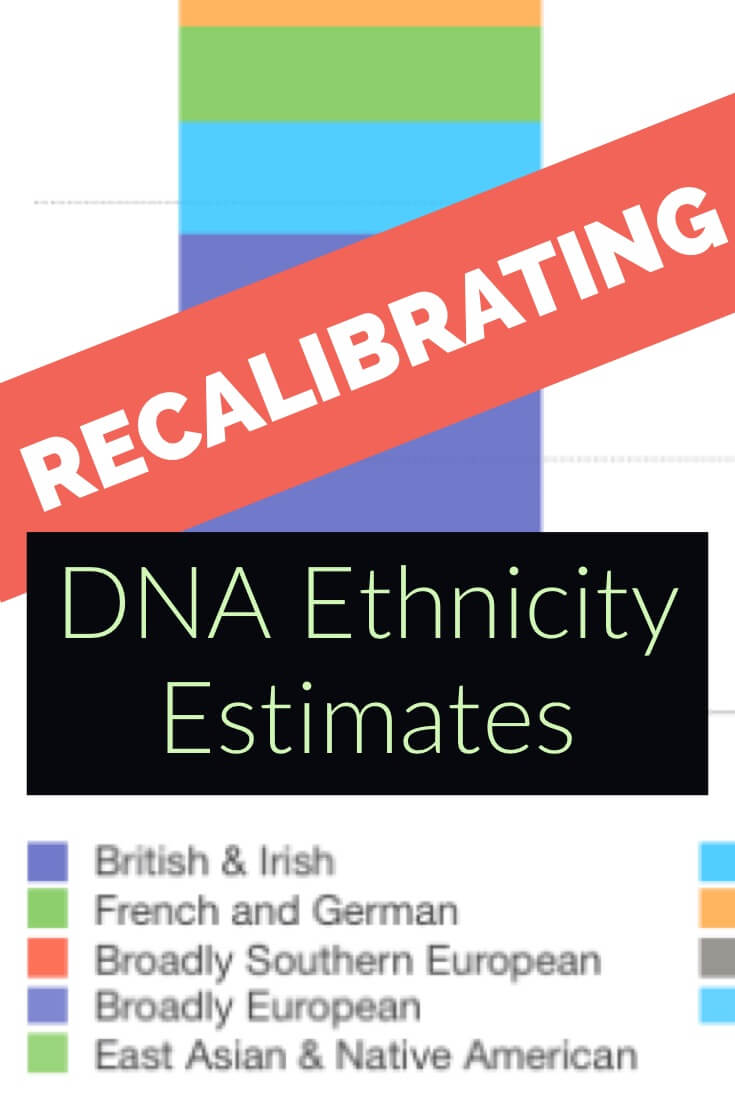 Genealogy testing companies have been hard at work recalibrating your ethnicity calculations based on new and better data. Here’s the latest from Your DNA Guide Diahan Southard.
Genealogy testing companies have been hard at work recalibrating your ethnicity calculations based on new and better data. Here’s the latest from Your DNA Guide Diahan Southard.
Family History DNA Pie Charts and Percentages
Remember that the pretty pie charts and percentages are based on fancy math and reference populations. The initial reference populations released by our testing companies were a great start, but many categories lacked sufficiently high numbers of people to represent all of the facets of a population. In the 10+ years since their release, many updates have been made. But the fancy math that is used to produce our percentages can only be as fancy as the numbers you give it. The numbers have been hard at work at Family Tree DNA, AncestryDNA and 23andMe in the past couple of months with the result being a major overhaul in the way our ethnicity results are reported.
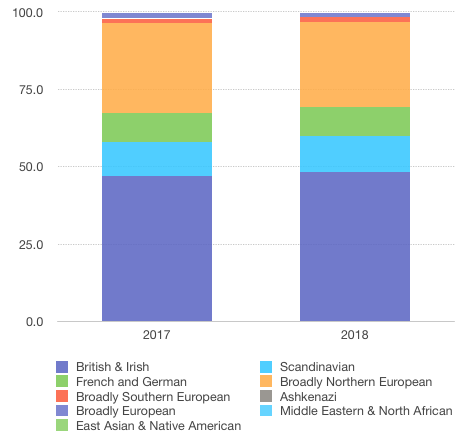
Image 1
23andMe
We recently reported about the update at 23andMe and their increase from 31 reference populations to 150. However, for me, the totally 100% European me, there wasn’t much excitement. As you can see in the 23andMe chart, I had a couple of numbers move up or down slightly, but not anything to write home about. However, I am certain those with South American, or Eastern European ancestry have a much different story. 23andMe added many new reference populations to better represent these underrepresented areas of the world, a move which has likely made a big difference for the ever diversifying pool of individuals who have taken a DNA test.
AncestryDNA
AncestryDNA also released their latest Ethnicity update in September, boasting an additional 13,000 reference samples to their database. They not only upgraded their numbers, but also shifted some of their categories around based on this new data. They seem to not be quite sure what to do with Ireland, as in early 2017 it was its own category, later moving in with Wales and Scotland, and now appears in this latest update as simply Ireland and Scotland. My previous numbers from AncestryDNA seemed to at least loosely reflect my heritage (meaning that I do actually have people in my genealogy chart from a few of these places).
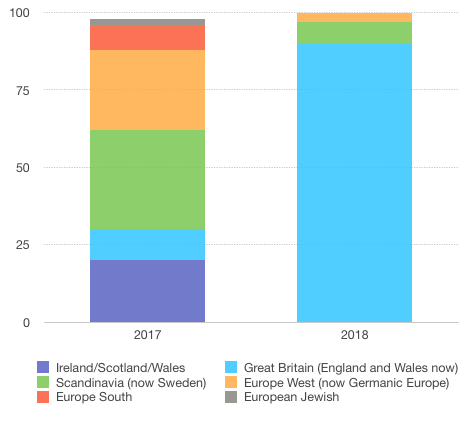
Image 2
But the new DNA numbers? Big Changes.
I have one set of great grandparents from Germany, but it looks like nearly all my German was sucked into England, but miraculously, they seemed to have precisely found my Swedish 2X great grandmother, with the 7% that I should have from that area.
With the new update, though I am sad to see my German go, AncestryDNA is now more fully in line with the results I have received from 23andMe, LivingDNA, and MyHeritage, all of which put my England/British Isles count up around 90%. If I compare my results from various companies and combine any subcategories into one England/British Isles category, indicate Scandinavian, and then lump everything else together, the results from the four companies are actually quite similar (I don’t have my own results at Family Tree DNA, only my parents).
My Family History DNA Results
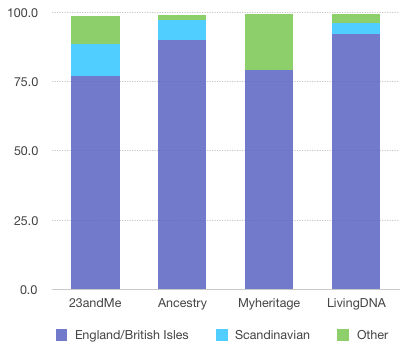
Image 3
Here’s how my results currently stack up at each of these websites. (Image 3)
Which DNA Testing Company to Choose
So which company is the best at all of this? Well, I usually say that if you test everywhere, your “true” answer is likely somewhere in the middle. But really, you can determine which company is best for you by examining their reference populations, and determining which company is most likely able to meet your goals.
In the end, it is always good to remember two things:
- Your DNA does not fully represent your family history, so your ethnicity results can’t possibly tell you everything about your heritage.
- This technology is purposefully titled as an estimate. So be sure you treat it that way.
Learn More about Genetic Genealogy
Recommended reading at Genealogy Gems: Understanding DNA Ethnicity Estimates
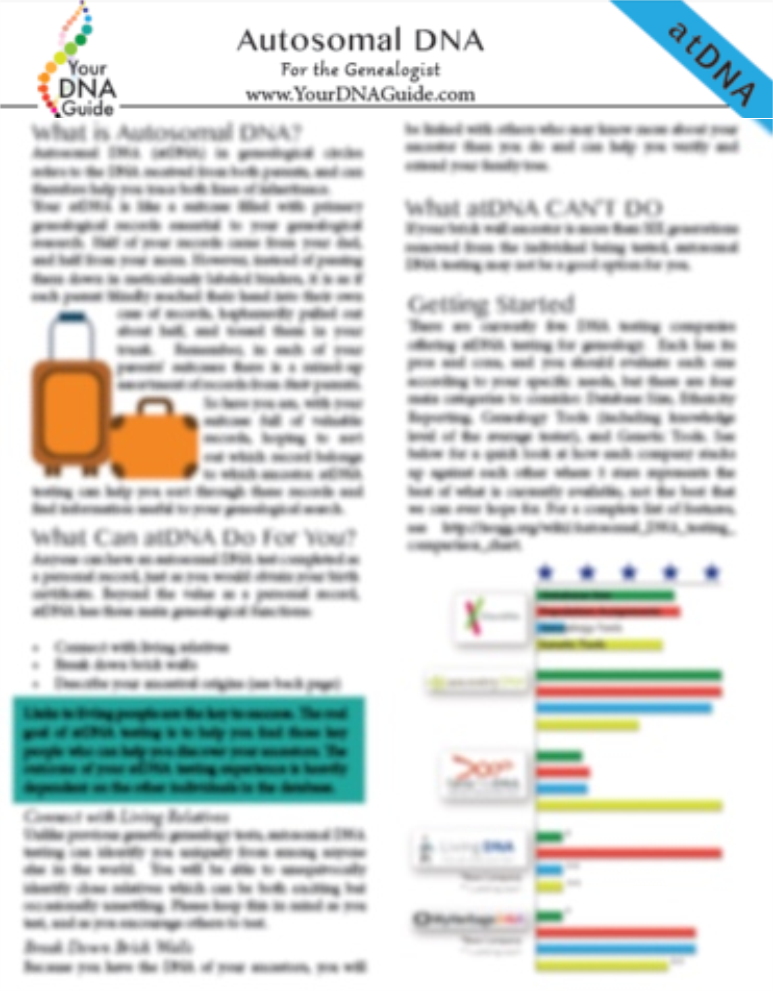
Get Diahan’s quick reference guides including Autosomal DNA for the Genealogist at the Genealogy Gems store.
 The MyHeritage DNA Health + Ancestry kit is available at the price of $199 + shipping. Users who have already purchased a MyHeritage DNA test for ethnicity and genealogy matching can upgrade to receive health reports for $120. To order, visit the MyHeritage DNA website. An annual Health subscription is available as an optional add-on to the new DNA kit, which grants users access to new health reports as they are released. As a special benefit for the launch, the Health subscription is currently offered for free for the first twelve months and users can cancel it anytime.
The MyHeritage DNA Health + Ancestry kit is available at the price of $199 + shipping. Users who have already purchased a MyHeritage DNA test for ethnicity and genealogy matching can upgrade to receive health reports for $120. To order, visit the MyHeritage DNA website. An annual Health subscription is available as an optional add-on to the new DNA kit, which grants users access to new health reports as they are released. As a special benefit for the launch, the Health subscription is currently offered for free for the first twelve months and users can cancel it anytime.

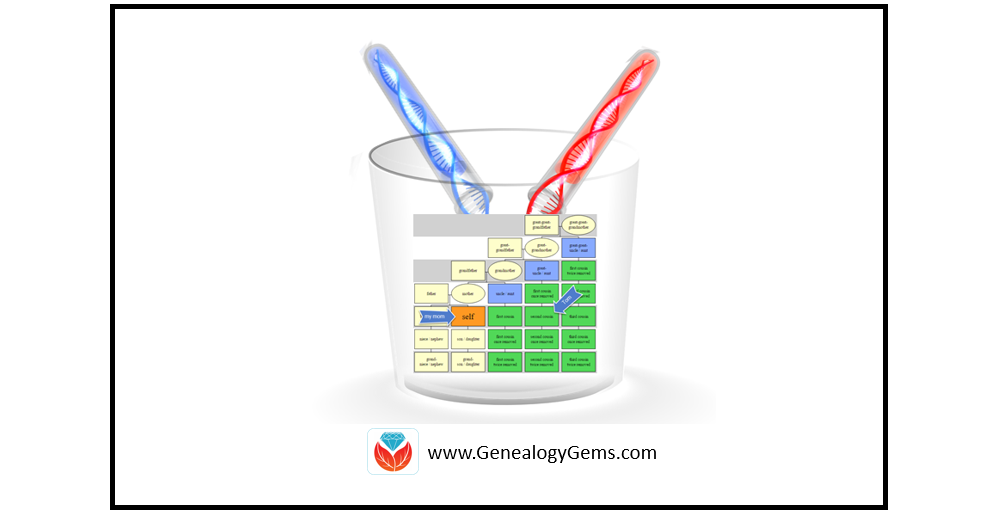


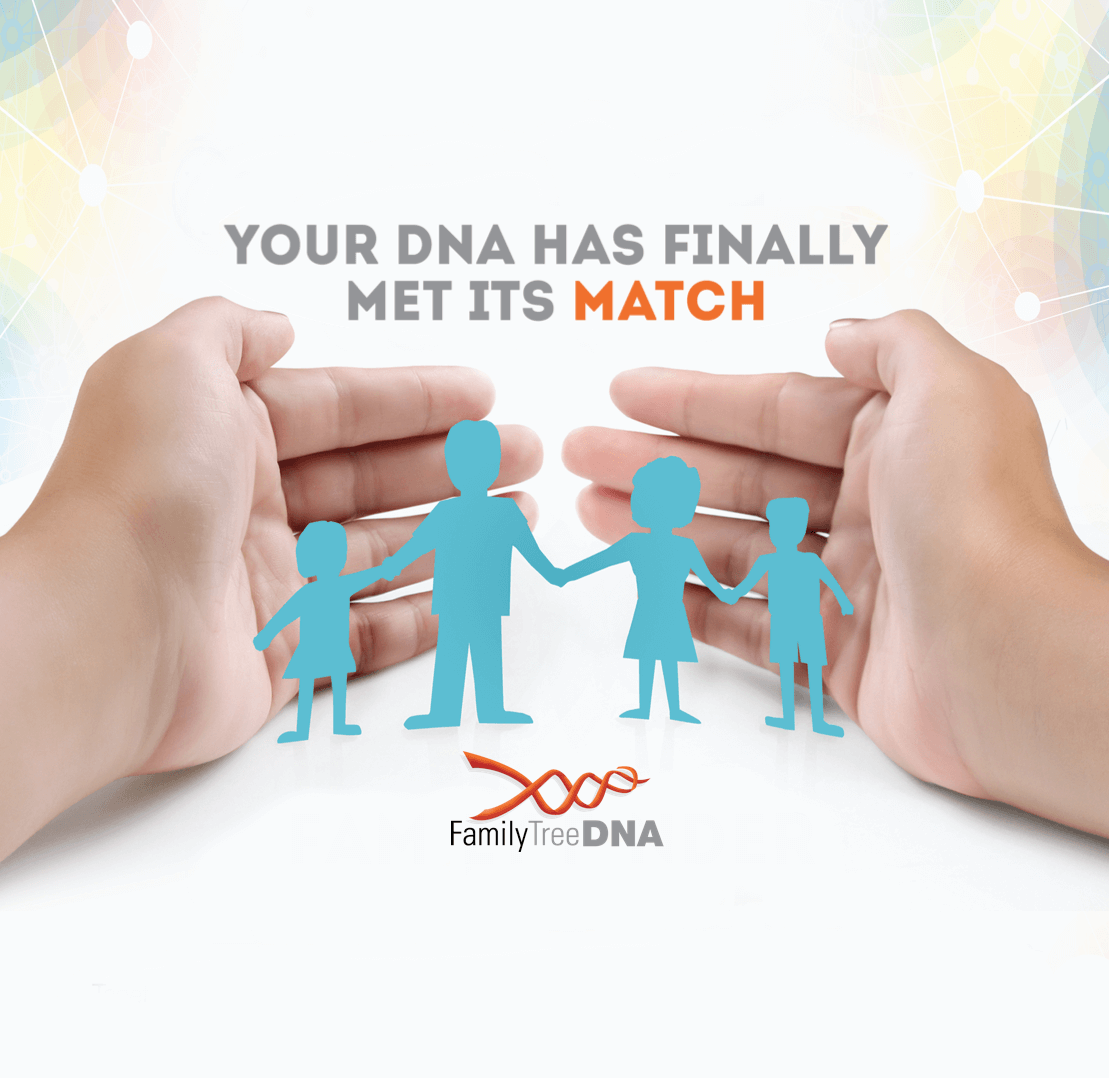

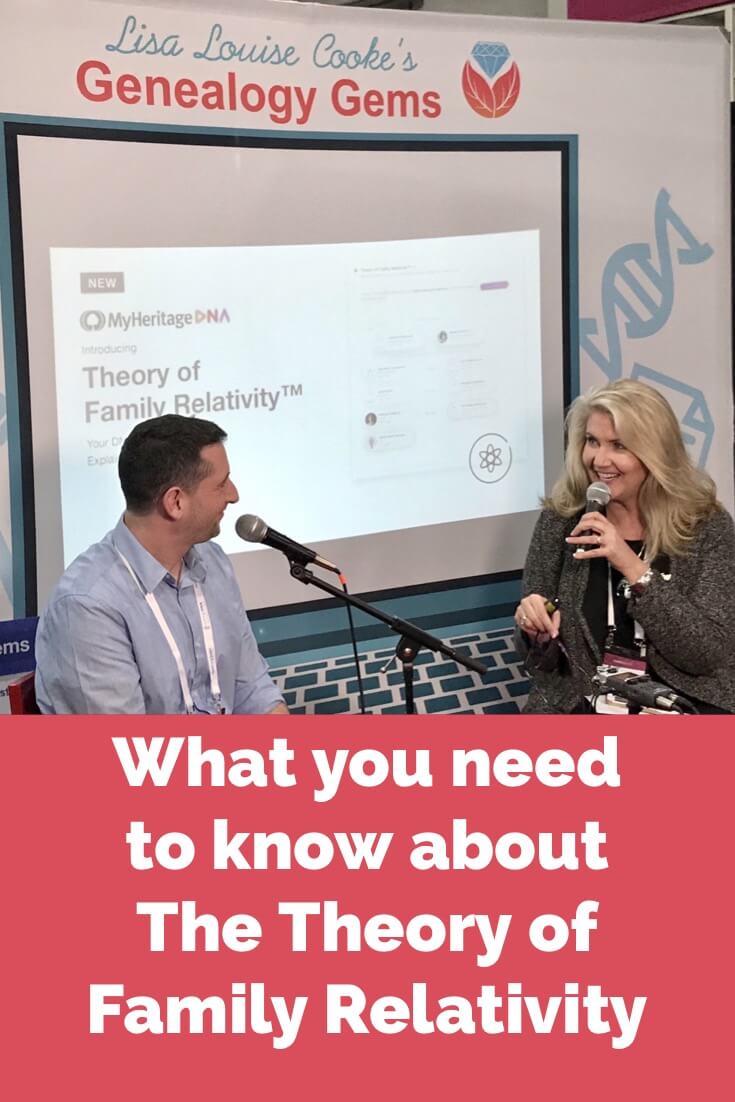

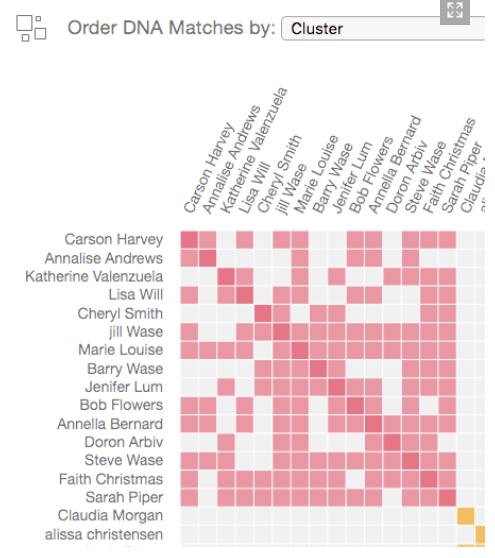
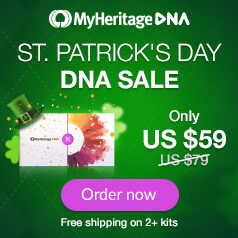


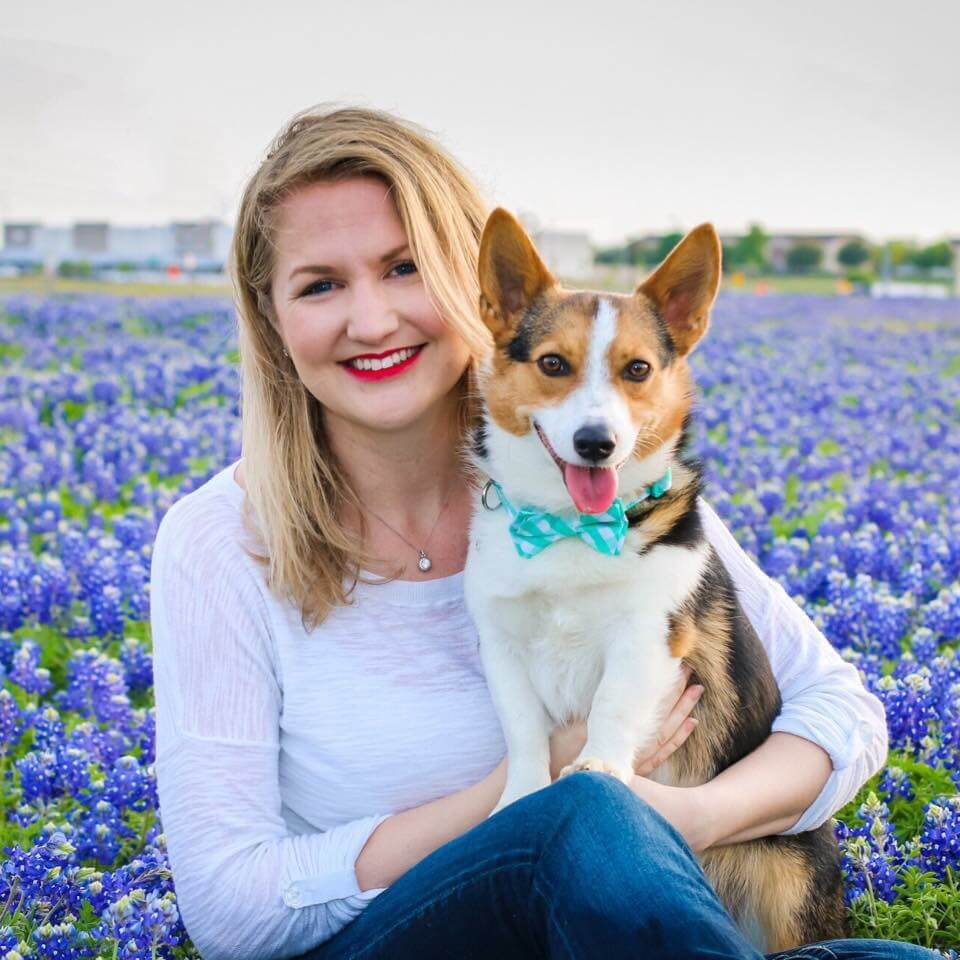
 Genealogy testing companies have been hard at work recalibrating your ethnicity calculations based on new and better data. Here’s the latest from Your DNA Guide Diahan Southard.
Genealogy testing companies have been hard at work recalibrating your ethnicity calculations based on new and better data. Here’s the latest from Your DNA Guide Diahan Southard. 


